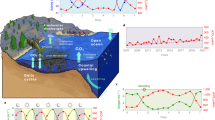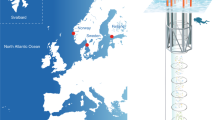Abstract
In the Brown et al. study ‘Increased food supply mitigates ocean acidification effects on calcification but exacerbates effects on growth’ they show disagreement with the tested hypothesis and data analysis methodology used in our 2016 study. We acknowledge careful criticism and a constructive dialogue are necessary to progress science and address these issues in this reply.
Replying to: Brown et al. Sci. Rep. 8 (2018); https://doi.org/10.1038/s41598-018-28012-w.
Similar content being viewed by others
Introduction
In our 2016 article in Scientific Reports1, we described the first meta-analysis synthesizing the results of experimental studies that to date had evaluated the role of food availability on susceptibility to ocean acidification of calcifying species. Our results supported the hypothesis that under high food availability, marine calcifiers are capable to mitigate the negative impacts of ocean acidification (OA). The re-examination of our study offered by Brown et al.2 presents a re-analysis of our results using a different methodological framework to, finally, offer similar results and conclusions as we achieved, with minor deviations despite issuing criticisms to our approach.
The main assertions of Brown et al.2 are based on:
-
1.
We test a different hypothesis than the one we proposed. We did not. We evaluated how OA affected responses across a range of food availability. Indeed, Brown et al.’s2 results are consistent with ours, showing that negative effects of OA on calcification were alleviated by high food supply and, also, food supply leads to increased growth under OA scenarios and ambient conditions.
-
2.
Our analysis used inadequate methodology (control treatment selection) by comparing both the high food acidified treatment and the low food acidified treatment to a common reference treatment (high food-non acidified treatment). It is correct that the use of “ambient CO2+ high/ambient food supply” as a common control hampers the exact attribution of OA, starvation or their combination as driver for the low calcification response and the low growth response in the low- and intermediate food-supply treatments. In these cases, we can conclude that simultaneous exposure to OA and food deprivation has a large negative impact relative to well-fed, non-acidified controls”. For the “high food-supply treatments” (where the control and treatment can only differ in terms of OA) we can conclude that there is no significant effect of OA on calcification or growth when food is supplied. In our study, we pose the question of how organisms are affected by OA under different food scenarios, and clearly show that potentially negative responses to OA were alleviated when food was supplied as opposed to the situation where the organisms were starved. This conclusion is consistent with that of Brown et al., despite the difference in approach to the analysis and the data sets used, indicating that this is indeed a robust finding.
The decision of what treatments to use as control conditions was based on, with one exception3, the fact that studies incorporated in the meta-analysis did not define “control food conditions” properly. Hence, a standardization was necessary to enable comparisons, which was provided by selecting a common condition (with higher food) as control or reference condition.
-
3.
Errors we committed when extracting data from selected studies could have determined our results and conclusions. Although Brown et al.2 indeed detected some mistakes (but far fewer than they claim), Brown and colleagues2 re-analyzed our data, after correcting these minor mistakes, to reach similar results and conclusions as those in our article. Hence, these errors did not affect the conclusions.
Thus, we believe that the re-analysis and methodology used by Brown et al.2 does not refute our original findings but expands the hypothesis and implications in studies focused on the effects of OA in combination with other stressors, as well as the interactive or additive nature of these effects. Their approach also highlights the complexities involved in estimating univariate measurements (effects sizes) from factorial experimental designs. However, without deepening the potential bias due to the still reduced number of studies4 (sample size) and dependence between variables used in any meta-analysis studies, the scope of the Brown et al.2 approach must be considered with caution in light of their conclusions. In particular, the statement that food would exacerbate the effects of OA on growth responses seems exaggerated. In their discussion Brown et al.2 neglect that, in most cases, calcification is more negatively affected under OA than growth5. Indeed calcification is an energetically-expensive biological process6, and maintaining calcification rates in the presence of food limitation imposes physiological trade-offs on other biological features7 (e.g., lower growth rates to maintain normal calcification rates and shell functionality).
Finally, we want to highlight that the low sample size in both studies1,2 implies that further efforts to experimentally resolve the role of food supply on responses to OA conditions are required to conclusively resolve this important question.
References
Ramajo, L. et al. Food supply confers calcifiers resistance to ocean acidification. Sci. Rep. 6, 19374 (2016).
Brown, N. E. M. et al. Increased food supply mitigates ocean acidification effects on calcification but exacerbates effects on growth. Sci. Rep. 8 (2018).
Edmunds, P. J. Zooplanktivory ameliorates the effects of ocean acidification on the reef coral Porites spp. Limnol. Oceanogr. 56, 2402–2410 (2011).
Valentine, J. C. et al. How many studies do you need? A primer on statistical power for meta-analysis. J. Educ. Behav. Stat. 35, 215–247 (2010).
Kroeker, K. J. et al. Impacts of ocean acidification on marine organisms: quantifying sensitivities and interactions with warming. Glob Change Biol. 19, 1884–1896 (2013).
Paine, R. T. A short-term experimental investigation of resource partitioning in a New Zealand rocky intertidal habitat. Ecology 52, 1096–1105 (1971).
Kelly, M. W. & Hofman, G. E. Adaptation and the physiology of ocean acidification. Funct Ecol. 27, 980–990 (2013).
Acknowledgements
This work was funded by ASSEMBLE grant agreement No. 227799 from European Community and from the Spanish Ministry of Economy and Competitiveness (ESTRESX, number CTM2012-32603). L.R. acknowledges support from grant FONDECYT 3170156. L.R. and N.L. acknowledge support from grant NC 1200286 (Millennium Nucleus Project MUSELS) and PIA CONICYT ANILLOS ACT172037. I.E.H. was supported by Ramon y Cajal Fellowship RYC2014-14970, cofunded by the Conselleria d’Innovació, Recerca i Turisme of the Balearic Government (Pla de ciència, tecnologia, innovació i emprenedoria 2013–2017) and the Spanish Ministry of Economy, Industry and Competitiveness.
Author information
Authors and Affiliations
Contributions
L.R., I.E.H. and C.M.D. wrote the main manuscript text. All authors reviewed and discussed the manuscript.
Corresponding author
Ethics declarations
Competing Interests
The authors declare no competing interests.
Additional information
Publisher's note: Springer Nature remains neutral with regard to jurisdictional claims in published maps and institutional affiliations.
Rights and permissions
Open Access This article is licensed under a Creative Commons Attribution 4.0 International License, which permits use, sharing, adaptation, distribution and reproduction in any medium or format, as long as you give appropriate credit to the original author(s) and the source, provide a link to the Creative Commons license, and indicate if changes were made. The images or other third party material in this article are included in the article’s Creative Commons license, unless indicated otherwise in a credit line to the material. If material is not included in the article’s Creative Commons license and your intended use is not permitted by statutory regulation or exceeds the permitted use, you will need to obtain permission directly from the copyright holder. To view a copy of this license, visit http://creativecommons.org/licenses/by/4.0/.
About this article
Cite this article
Ramajo, L., Hendriks, I.E., Lagos, N.A. et al. Reply to ‘Increased food supply mitigates ocean acidification effects on calcification but exacerbates effects on growth’. Sci Rep 8, 9799 (2018). https://doi.org/10.1038/s41598-018-27670-0
Received:
Accepted:
Published:
DOI: https://doi.org/10.1038/s41598-018-27670-0
Comments
By submitting a comment you agree to abide by our Terms and Community Guidelines. If you find something abusive or that does not comply with our terms or guidelines please flag it as inappropriate.



